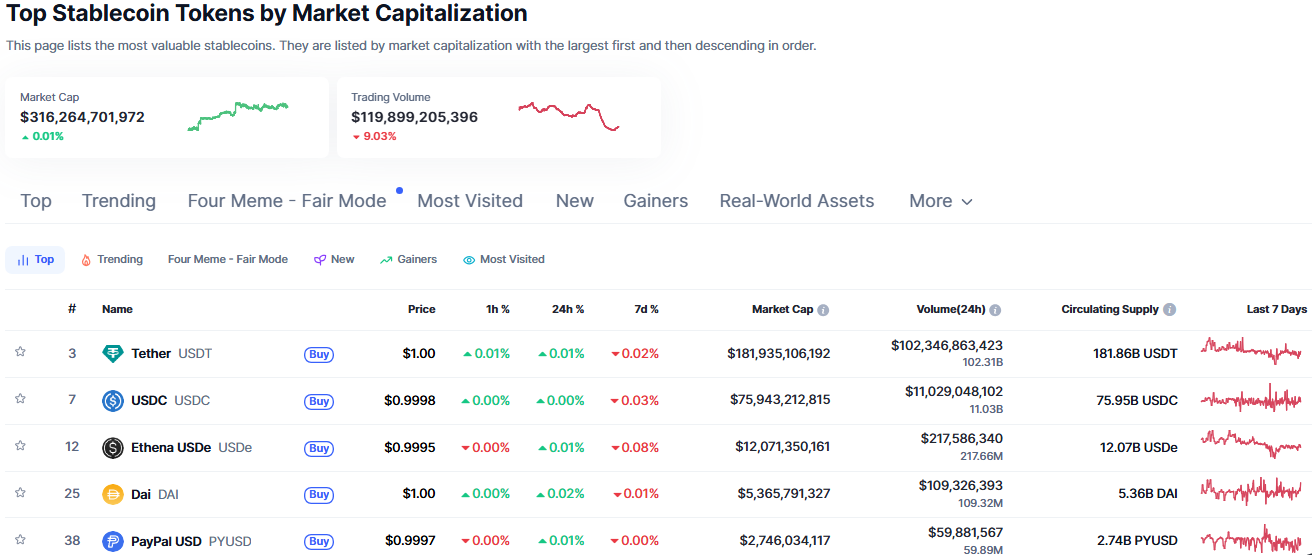Quick Breakdown:
- Stablecoins promise stability in crypto markets, but not all pegs are created equal.
- The U.S. dollar dominates the stablecoins list, with USDT and USDC leading global liquidity and trust.
- Other stablecoin examples could enhance local payment systems, but face reserve and credibility challenges.
- Inflation and weak monetary policy expose major stablecoin risks, especially for tokens tied to unstable fiat currencies.
The Logic of “Stable”: What Defines a “Stablecoin”
A stablecoin is meant to be a digital asset designed to maintain a near-constant value, usually pegged 1:1 to a traditional fiat currency. But behind that simple promise lies a complex architecture that determines just how “stable” a stablecoin really is. Some are backed by real-world money or short-term government securities, sitting safely in bank accounts or treasuries; these are the fiat-backed versions. Others rely on cryptocurrencies locked up as collateral, with extra reserves built in to cushion against price swings. Then there are algorithmic stablecoins, which don’t depend on reserves at all but instead use code and market incentives to control supply and maintain balance.
There are many stablecoin examples in the market today that demonstrate these different models, from Tether (USDT) and USD Coin (USDC), which are fiat-backed, to DAI, which is crypto-collateralized, and even past algorithmic attempts like TerraUSD. Yet, no matter the design, the meaning of “stable” always comes down to two things: how credible and liquid the reserves are, and how trustworthy the underlying currency is. A token pegged to a strong, widely accepted currency like the U.S. dollar carries a very different kind of confidence than one linked to a currency battling runaway inflation.
Why the US Dollar Still Dominates the Peg Market
The U.S. dollar’s grip on the stablecoin market is no accident — it’s the result of trust, liquidity, and a financial ecosystem built around it. Nearly 98–99% of all stablecoins are pegged to the dollar, leaving little room for competitors like the euro or yen. Within this dollar-dominated space, Tether (USDT) and USD Coin (USDC) lead the pack, together holding over 80% of total capitalization. Simply put, the dollar has become the digital world’s default measure of stability.

This dominance stems from three key forces. First, liquidity and reserve strength. Stablecoin issuers backing tokens with U.S. Treasuries and cash deposits rely on the world’s deepest, safest, and most profitable markets. Short-term Treasury bills not only guarantee stability but also generate yields that support long-term sustainability.
Second, the dollar’s global influence is unmatched. It remains the world’s primary reserve and settlement currency, accounting for 57.8% of global reserves as of late 2024, according to IMF data.
Finally, network effects keep the cycle spinning. Most crypto platforms, liquidity pools, and DeFi protocols already operate in dollar terms. The more users transact in USD-pegged coins, the stronger their dominance becomes. This explains which stablecoin consistently earns the market’s trust and why, across any stablecoin list, dollar-backed tokens remain at the top.
The Case for Selective Currency Representation
If the U.S. dollar dominates the stablecoins list, why even consider other currencies? Not every nation’s currency deserves a digital twin, but in certain contexts, non-USD stablecoins make practical and economic sense. The euro, for instance, stands out as a strong candidate. With its vast economic base and integrated financial system, a euro-pegged stablecoin could reduce foreign exchange friction across the Eurozone and enhance local payment efficiency.
RELATED: Can Europe’s Stablecoin Ambitions Withstand Pressure From the US and China?
Other advanced economies with credible central banks and low, predictable inflation also present viable cases for stablecoin representation. Currencies like the Canadian dollar, British pound, and Swiss franc benefit from strong monetary institutions and deep, liquid financial markets. In these environments, a stablecoin could maintain its peg with confidence, backed by high-quality local reserves and transparent policy frameworks. These could serve as positive stablecoin examples that broaden global representation without introducing major stablecoin risks.
Beyond large economies, there are niche cases where a non-USD stablecoin could deliver real utility, particularly in cross-border remittance corridors. For instance, two neighbouring countries with close trade or familial ties but expensive banking systems could benefit from a local stablecoin that reduces transfer fees and settlement delays. Even if the local currency isn’t perfectly stable, the efficiency and transparency of blockchain rails could offer a meaningful improvement over traditional systems, provided the stablecoin risks are managed through transparency and reserve credibility.
Inflation, Credibility, and the Trust Equation
Stablecoins run on trust and the credibility of the currency backing them, not just on code or collateral. If users doubt that the reserves are real or redeemable, or that the peg will hold, the entire system falters. But beyond these technical layers lies a deeper question: what is the currency itself worth? Inflation directly tests this foundation. A token pegged to a currency losing value each month may remain “stable” by definition, but not in purchasing power.
Also Read: Is Crypto Adoption Strongest Where Fiat Is Weakest?
For users in places like Venezuela, Turkey, or Argentina, that distinction is everything. When local currencies crumble, they turn to dollar-based assets, not because they love the dollar, but because it preserves value in real terms. Stablecoins tied to weaker currencies struggle here. Their reserves erode, redemption becomes risky, and faith in the peg evaporates. This highlights one of the biggest stablecoin risks: no amount of smart contracts can compensate for a weak monetary base. That’s where regulation and transparency become non-negotiable.
Without independent audits and clear oversight, users have no proof that a coin’s backing is genuine. True stability, then, isn’t just about price parity; it’s about credibility, governance, and the enduring belief that what you hold today will still matter tomorrow. When evaluating which stablecoin is best, these fundamentals make all the difference.
The Global Outlook: Representation vs. Real Stability
The global stablecoin map paints a simple picture: it’s overwhelmingly dollar green. Nearly 99% of stablecoin value is pegged to the U.S. dollar, with USDT and USDC dominating circulation and trading. According to rankings of stablecoins by market cap, the top five stablecoins are all USD-based, reinforcing just how concentrated the market is. Other fiat-pegged stablecoins, like those linked to the euro, remain small players in a dollar-led digital world.
Yet, policymakers are pushing to change that. By encouraging local-currency stablecoins, they hope to boost domestic payment systems and assert more monetary control in an increasingly dollarized economy. However, as shown by current stablecoin examples, users still prefer the security, liquidity, and predictability of USD-pegged tokens. So even as new currencies go digital, trust and liquidity still circle back to the dollar— a reminder that the best stablecoin is the one where real financial confidence lies, and that not every currency should automatically get a stablecoin.
Disclaimer: This article is intended solely for informational purposes and should not be considered trading or investment advice. Nothing herein should be construed as financial, legal, or tax advice. Trading or investing in cryptocurrencies carries a considerable risk of financial loss. Always conduct due diligence.
If you want to read more market analyses like this one, visit DeFi Planet and follow us on Twitter, LinkedIn, Facebook, Instagram, and CoinMarketCap Community.





















